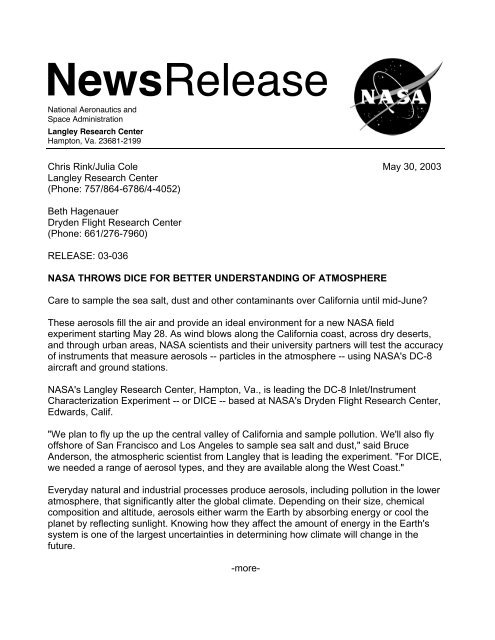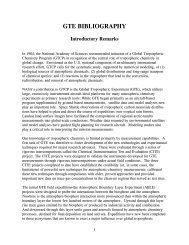NewsRelease - GTE - NASA
NewsRelease - GTE - NASA
NewsRelease - GTE - NASA
Create successful ePaper yourself
Turn your PDF publications into a flip-book with our unique Google optimized e-Paper software.
<strong>NewsRelease</strong><br />
National Aeronautics and<br />
Space Administration<br />
Langley Research Center<br />
Hampton, Va. 23681-2199<br />
Chris Rink/Julia Cole May 30, 2003<br />
Langley Research Center<br />
(Phone: 757/864-6786/4-4052)<br />
Beth Hagenauer<br />
Dryden Flight Research Center<br />
(Phone: 661/276-7960)<br />
RELEASE: 03-036<br />
<strong>NASA</strong> THROWS DICE FOR BETTER UNDERSTANDING OF ATMOSPHERE<br />
Care to sample the sea salt, dust and other contaminants over California until mid-June<br />
These aerosols fill the air and provide an ideal environment for a new <strong>NASA</strong> field<br />
experiment starting May 28. As wind blows along the California coast, across dry deserts,<br />
and through urban areas, <strong>NASA</strong> scientists and their university partners will test the accuracy<br />
of instruments that measure aerosols -- particles in the atmosphere -- using <strong>NASA</strong>'s DC-8<br />
aircraft and ground stations.<br />
<strong>NASA</strong>'s Langley Research Center, Hampton, Va., is leading the DC-8 Inlet/Instrument<br />
Characterization Experiment -- or DICE -- based at <strong>NASA</strong>'s Dryden Flight Research Center,<br />
Edwards, Calif.<br />
"We plan to fly up the up the central valley of California and sample pollution. We'll also fly<br />
offshore of San Francisco and Los Angeles to sample sea salt and dust," said Bruce<br />
Anderson, the atmospheric scientist from Langley that is leading the experiment. "For DICE,<br />
we needed a range of aerosol types, and they are available along the West Coast."<br />
Everyday natural and industrial processes produce aerosols, including pollution in the lower<br />
atmosphere, that significantly alter the global climate. Depending on their size, chemical<br />
composition and altitude, aerosols either warm the Earth by absorbing energy or cool the<br />
planet by reflecting sunlight. Knowing how they affect the amount of energy in the Earth's<br />
system is one of the largest uncertainties in determining how climate will change in the<br />
future.<br />
-more-
Scientists from Langley, the University of Hawaii, the University of New Hampshire and the<br />
Georgia Institute of Technology are contributing instruments to the DC-8 payload for the<br />
DICE campaign. They will compare aircraft instrument measurements among each other<br />
and to observations from aerosol-monitoring ground stations located in California, including<br />
ones at Dryden, Rogers Dry Lake and Trinidad Head.<br />
DICE will enable the scientists to better understand data from past field experiments and<br />
prepare for activities in <strong>NASA</strong>'s Intercontinental Chemical Transport Experiment-North<br />
America or INTEX-NA. Scheduled for summer 2004, INTEX-NA will study the exchange of<br />
chemicals and aerosols between the land and lower atmosphere over the U.S. East Coast.<br />
"For INTEX-NA, scientists will look at the quantity of pollution over North America and how<br />
that pollution is transported across the Atlantic Ocean to Europe," Anderson said.<br />
INTEX-NA will be the latest in a series of <strong>NASA</strong> field campaigns to better understand the<br />
worldwide chemistry of the troposphere or the lower atmosphere. Over the past twenty<br />
years, <strong>NASA</strong> has conducted missions in the Amazon, the Arctic, the tropical Atlantic and the<br />
Pacific to study both natural and human-made processes that determine the troposphere's<br />
chemical makeup.<br />
The second phase of INTEX-NA is scheduled for spring 2006. This international research<br />
effort is part of <strong>NASA</strong>'s Earth Science Enterprise, dedicated to understanding and protecting<br />
our home planet.<br />
-2-<br />
-end-





